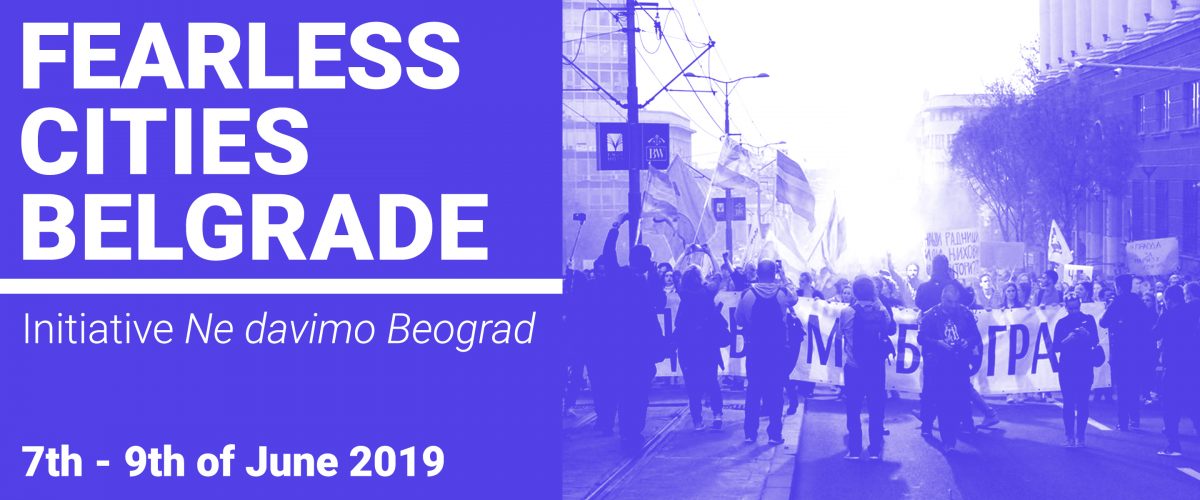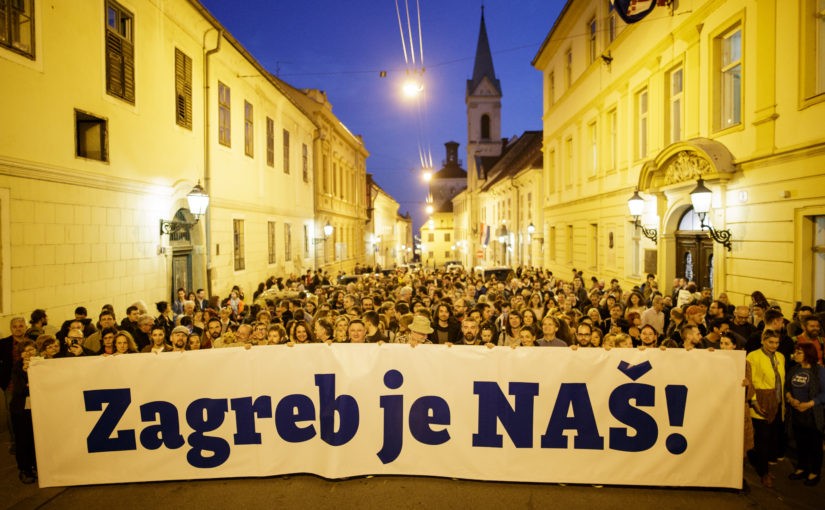From the streets to the town halls: local governance and municipalist platforms in Croatia and Serbia
Over the last years, Croatia and Serbia witnessed the emergence of municipalist platforms which ran for local elections in Zagreb (2017) and Belgrade (2018). Choosing the local level of government as an entry point, these city platforms were inspired by Barcelona en Comú and other experiences that “focus on the municipality as a strategic site for developing transformative and prefigurative politics”, as worded by Bertie Russell in this contribution. In both Croatia and Serbia, these civic lists sprung from right to the city groups engaged for years in activism against aggressive urbanism, rampant privatization of public lands and gentrification processes. In 2017 the Croatian activist group “Zagreb is Ours” (Zagreb je naš) formed an electoral platform together with other leftist and green parties with the aim of “building a new politics based on the principles of wide participation, inclusiveness and openness”. Choosing the municipal scale to approach institutional politics, in May 2017 the platform gained 7.6% of the votes, succeeding in electing more than sixty councillors to the Zagreb City Assembly, city districts and local councils.
After years of engagement in urban social struggles, the Serbian initiative “Don’t let Belgrade d(r)own” (Ne davimo Beograd) adopted a similar approach in opting to run for the March 2018 city elections. Formed in 2014, the initiative has been opposing the massive urban redevelopment project “Belgrade Waterfront”, which is transforming the Serbian capital into a gigantic construction site and dismantling an entire neighbourhood to make space for luxurious commercial and residential buildings that leave local citizens priced out. Whilst “Don’t let Belgrade d(r)own” achieved 3.5% of votes, this fell short of the 5% threshold required for representation in the Belgrade’s city council. The activities of “Don’t let Belgrade d(r)own” continued after the elections, and the initiative hosted the “Fearless cities” summit in June 2019.

Building on the historical legacy of local self-government
Although both collectives achieved different electoral outcomes, they share a similar path that drove them from contention to electoral competition at the local level. Likewise, both “Zagreb is Ours” and “Don’t let Belgrade d(r)own” attempted to actively involve citizens in the elaboration of the political program, promoting a participatory approach which combined in-person assemblies and meetings in the neighborhoods with online forums. Thematic groups were in charge of developing proposals tackling pressing issues such as housing, urbanism, health, culture and the like, which could be voted online and prioritized in the online forums. The two groups also share a specific historical context, both countries having been part of socialist Yugoslavia from the end of the Second World War until its dissolution in the 1990s.
Alongside finding ways to foster political engagement and decision-making of citizens at the local level, these platforms also look to reappraise the historical experience of socialism – something mostly disregarded and neglected in the public opinion. Thirty years after the breakup of Yugoslavia, the activists claim, it is time to look back at the self-government experience of socialism with critical lenses, deprived of nostalgic feelings, but at the same time being able to grasp the positive sides of the practices implemented during that period. The idea of local self-government advocated by both groups is thus particularly interesting, as it is in tune with that promoted by municipalist-based local governments in the US and Western Europe, and influenced by the past experience of local self-government that stood at the core of the Yugoslav socialist system.
In spite of suffering from low international exposure, municipalist experiences arisen at the semi-periphery of Europe are of particular interest for two reasons. First, they help to comprehend how the municipalist model can be articulated and adapted to diverse circumstances, being enriched by the specificities of the local context in which it is adopted. Second, they reveal the extent to which the municipalist discourse can resonate in contexts with a different heritage, maintaining its message unchanged: the centrality of citizens’ political participation and the transformation of policy processes starting from the local level of government.

What is thus peculiar about the municipalist experiences in Croatia and Serbia? How do activists manage to articulate a municipalist discourse whilst giving it “a regional flavour”? Aware of the different background and contentious history that distinguish their contexts from the Western European one, they looked back to delve into their history of community self-management, one rooted in local communities as structures of local self-government which fostered citizens’ participation in the decision-making process.
Local communities as structures of local self-government
To enhance participation through institutions of direct participation of citizens, city-platforms in Zagreb and Belgrade advocate for the need to give more power and autonomy to the lower levels of governance, the local communities, which are a legacy of the socialist regime. Local communities (mjesne zajednice), which can be translated also as “neighborhood councils”, were the lowest territorial and functional units of communal self-government. Unique institutions established in both rural and urban areas under socialism, they represented a form of direct citizen participation on local issues relevant for the community. The political administration of the state was envisioned to occur through the network of local communities and flow upwards towards the republican and state legislatures, explains Jasmin Mujanović in his book Hunger and Fury. In this system, local matters were delegated to these administrative units below the municipal level that allowed citizens to organise collectively, as well as to address many of the local day-to-day governance issues that directly affected their lives, as put by Roberto Belloni in his latest book State building and international intervention in Bosnia. In practice, however, the control exercised by the socialist regime over state and society limited their role, preventing them from appropriately fulfilling their purposes. This discrepancy between the potential of local communities and the way in which they actually worked constitutes the main point of criticism for local activists. Nowadays, most of the mjesne zajednice have been emptied of their original function, losing their administrative tasks and legal positions, as well as their local self-government functions. Basically, they are reduced to representative bodies of municipal offices in neighborhoods. Revitalizing and strengthening their power, activists in Croatia and Serbia argue, would help to bring power closer to the citizens, encouraging their direct participation in governance and decision-making in matters of common interest. This decentralization goes in the opposite direction of the centralization flow that has occurred over the last years in particular in the city of Belgrade.
The socialist tradition of self-government based on local communities, combined with the current examples of municipalist-based local governments, are thus two models that stand at the core of what I like to call “the post-Yugoslav version of municipalism” proposed in Croatia and Serbia. The peculiarity of this model rests on its unique approach, which combines a critical re-examination of the community self-management, the heritage of the socialist regime, and the inspiration the present experiences and practices in the US and Europe provide, towards building a new model of radical democracy.
Which future for radical democracy in Serbia and Croatia?
In conclusion, what are the opportunities and limits offered by municipalist projects at the European semi-periphery? First of all, it is important to notice how, in a region characterized by a low tradition of citizen activism, social conflict stemmed from struggles related to the privatization and commodification of the public space. Both “Zagreb is Ours” in Croatia and “Don’t let Belgrade d(r)own” in Serbia began by engaging in urban social struggles, emerging out of a shared resentment towards a model of urbanism that was dispossessing the local population from their cities, relegating it to the margins of both their habitat and of the decision-making process. However, the urban environment in which these groups sprung represents at the same time their strength and their weakness. If, on the one hand, the urban context offers the breeding ground where mobilization over urban inequalities and rising costs of living arises, on the other hand it risks limiting their support base to predominantly the urban middle-class living in the capitals.
Specific factors related to the local context represent another constraint for the platforms’ activities. In Croatia, “Zagreb is Ours” is experiencing the pitfalls deriving from the so-called institutionalization of movements, meaning the drain of human resources from the streets to the institutions. Activists and supporters who were previously engaged in movement activities now face the burden of dealing with daily administrative issues and the everyday commitment their new institutional role requests. In Serbia, the extent of repression exerted against political opponents, and in particular the activists of the leftist scene, constitutes not only a factor of concern, but also a concrete obstacle to their activity, frequently obstructed by the pressure exercised by the authoritarian regime. Monitoring, phone tapping, and a large number of court processes drain resources from the movement; media control and smear campaigns against activists on the tabloids controlled by the government make their engagement even more costly. Nevertheless, both municipalist experiences are succeeding in uniting a broader coalition of actors at the national level: the Civic front (Građanski Front), which gathers eight organizations across Serbia fighting against corruption and the privatization of public goods at the local level; and the Možemo (We can) political platform in Croatia. Furthermore, they both bear the potential for triggering social change in the countries, especially if they stay faithful to their intention of struggling both outside and within institutions. And most importantly, so far, they have already played an important role in destabilizing the political landscape in both political scenes, putting themselves at the forefront of a struggle for radical democracy started from the grassroots.
The author’s research about municipalism in the region has received funding from the European Union’s Horizon 2020 research and innovation programme under the Marie Skłodowska-Curie grant agreement No 792782 “Reclaiming the Cities in the post-Yugoslav space”
Featured image: The yellow duck, symbol of “Don’t let Belgrade d(r)own”, facing a policeman.
Photo: Nedavimobeograd.rs

